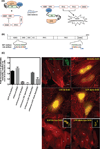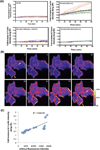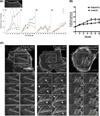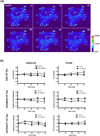An optogenetic tool for the activation of endogenous diaphanous-related formins induces thickening of stress fibers without an increase in contractility
- PMID: 23677607
- PMCID: PMC4064713
- DOI: 10.1002/cm.21115
An optogenetic tool for the activation of endogenous diaphanous-related formins induces thickening of stress fibers without an increase in contractility
Abstract
We have developed an optogenetic technique for the activation of diaphanous-related formins. Our approach is based on fusion of the light-oxygen-voltage 2 domain of Avena sativa Phototrophin1 to an isolated Diaphanous Autoregulatory Domain from mDia1. This "caged" diaphanous auto-regulatory domain was inactive in the dark but in the presence of blue light rapidly activated endogenous diaphanous-related formins. Using an F-actin reporter, we observed filopodia and lamellipodia formation as well as a steady increase in F-actin along existing stress fibers, starting within minutes of photo-activation. Interestingly, we did not observe the formation of new stress fibers. Remarkably, a 1.9-fold increase in F-actin was not paralleled by an increase in myosin II along stress fibers and the amount of tension generated by the fibers, as judged by focal adhesion size, appeared unchanged. Our results suggest a decoupling between F-actin accumulation and contractility in stress fibers and demonstrate the utility of photoactivatable diaphanous autoregulatory domain for the study of diaphanous-related formin function in cells.
Keywords: actin polymerization; actomyosin contractility; diaphanous-related formins; light-oxygen-voltage domain; optogenetics; stress fiber.
Copyright © 2013 Wiley Periodicals, Inc.
Figures






Similar articles
-
Biochemical characterization of the Rho GTPase-regulated actin assembly by diaphanous-related formins, mDia1 and Daam1, in platelets.J Biol Chem. 2008 Mar 28;283(13):8746-55. doi: 10.1074/jbc.M707839200. Epub 2008 Jan 24. J Biol Chem. 2008. PMID: 18218625
-
Rho activation of mDia formins is modulated by an interaction with inverted formin 2 (INF2).Proc Natl Acad Sci U S A. 2011 Feb 15;108(7):2933-8. doi: 10.1073/pnas.1017010108. Epub 2011 Jan 28. Proc Natl Acad Sci U S A. 2011. PMID: 21278336 Free PMC article.
-
FHOD proteins in actin dynamics--a formin' class of its own.Small GTPases. 2014;5(2):11. doi: 10.4161/21541248.2014.973765. Small GTPases. 2014. PMID: 25483300 Free PMC article. Review.
-
The diaphanous-related formins promote protrusion formation and cell-to-cell spread of Listeria monocytogenes.J Infect Dis. 2015 Apr 1;211(7):1185-95. doi: 10.1093/infdis/jiu546. Epub 2014 Oct 3. J Infect Dis. 2015. PMID: 25281757 Free PMC article.
-
Mechanostress resistance involving formin homology proteins: G- and F-actin homeostasis-driven filament nucleation and helical polymerization-mediated actin polymer stabilization.Biochem Biophys Res Commun. 2018 Nov 25;506(2):323-329. doi: 10.1016/j.bbrc.2018.09.189. Epub 2018 Oct 9. Biochem Biophys Res Commun. 2018. PMID: 30309655 Review.
Cited by
-
Optogenetic Control of Protein Function: From Intracellular Processes to Tissue Morphogenesis.Trends Cell Biol. 2016 Nov;26(11):864-874. doi: 10.1016/j.tcb.2016.09.006. Epub 2016 Oct 7. Trends Cell Biol. 2016. PMID: 27727011 Free PMC article. Review.
-
Light Activates Cdc42-Mediated Needle-Shaped Filopodia Formation via the Integration of Small GTPases.Cell Mol Bioeng. 2022 Oct 6;15(6):599-609. doi: 10.1007/s12195-022-00743-x. eCollection 2022 Dec. Cell Mol Bioeng. 2022. PMID: 36531863 Free PMC article.
-
Optogenetic control of cellular forces and mechanotransduction.Nat Commun. 2017 Feb 10;8:14396. doi: 10.1038/ncomms14396. Nat Commun. 2017. PMID: 28186127 Free PMC article.
-
Natural photoreceptors as a source of fluorescent proteins, biosensors, and optogenetic tools.Annu Rev Biochem. 2015;84:519-50. doi: 10.1146/annurev-biochem-060614-034411. Epub 2015 Feb 20. Annu Rev Biochem. 2015. PMID: 25706899 Free PMC article. Review.
-
Optogenetic approaches to cell migration and beyond.Curr Opin Cell Biol. 2014 Oct;30:112-20. doi: 10.1016/j.ceb.2014.08.004. Epub 2014 Sep 15. Curr Opin Cell Biol. 2014. PMID: 25216352 Free PMC article. Review.
References
-
- Alberts AS. Identification of a carboxyl-terminal diaphanous-related formin homology protein autoregulatory domain. J Biol Chem. 2001;276(4):2824–2830. - PubMed
-
- Amano M, Chihara K, Kimura K, Fukata Y, Nakamura N, Matsuura Y, Kaibuchi K. Formation of actin stress fibers and focal adhesions enhanced by Rho-kinase. Science. 1997;275(5304):1308–1311. - PubMed
-
- Balaban NQ, Schwarz US, Riveline D, Goichberg P, Tzur G, Sabanay I, Mahalu D, Safran S, Bershadsky A, Addadi L, et al. Force and focal adhesion assembly: a close relationship studied using elastic micropatterned substrates. Nat Cell Biol. 2001;3(5):466–472. - PubMed
-
- Bershadsky AD, Ballestrem C, Carramusa L, Zilberman Y, Gilquin B, Khochbin S, Alexandrova AY, Verkhovsky AB, Shemesh T, Kozlov MM. Assembly and mechanosensory function of focal adhesions: experiments and models. Eur J Cell Biol. 2006;85(3–4):165–173. - PubMed
Publication types
MeSH terms
Substances
Grants and funding
LinkOut - more resources
Full Text Sources
Other Literature Sources
Research Materials

